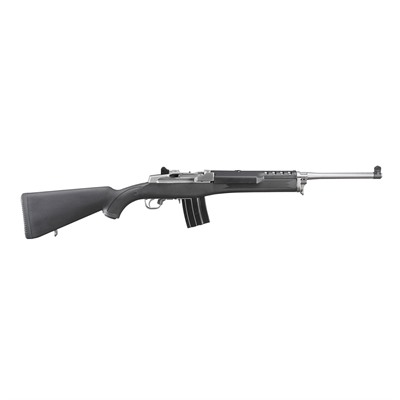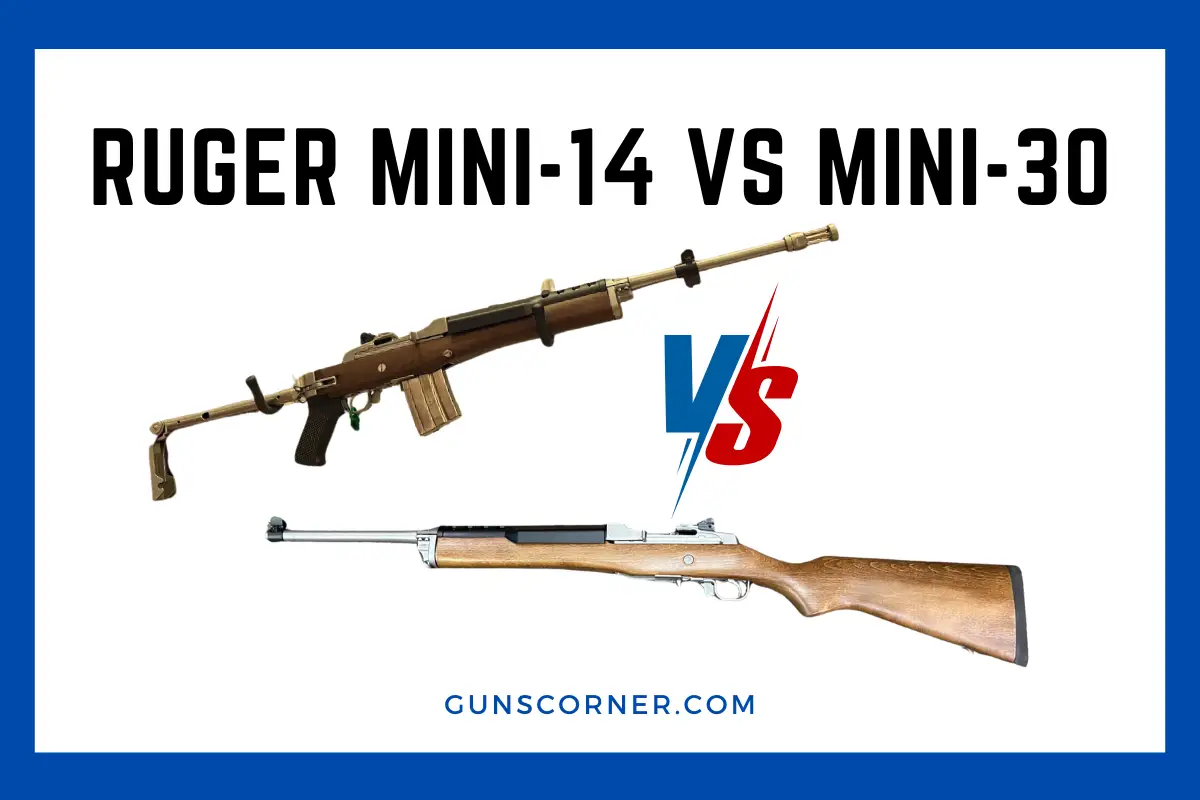The Ruger Mini-14 and Mini-30 are two rifles that often come up in discussions among firearm enthusiasts and hunters. Despite their external similarities and shared heritage, these rifles are distinct in their design, caliber, and intended use.
The Mini-14, primarily chambered in .223/5.56mm, is known for its use in ranching, small-game hunting, and by some law enforcement agencies. On the other hand, the Mini-30 fires the larger 7.62x39mm round, which is popular for its stopping power and is often preferred for hunting larger game.
These rifles also differ in their historical context and have developed unique reputations within the gun community. The Mini-14 was introduced in the early 1970s and gained a following for its resemblance to the military M14, while the Mini-30, introduced later, has been embraced by those who appreciate the more powerful ammunition it accommodates. Both models have seen various iterations and upgrades over the years, with Ruger offering different configurations to suit a variety of shooting styles and preferences.
In terms of performance, shooters typically weigh the accuracy and ballistics of the two rifle types in relation to their intended applications.
Key Takeaways
- The Ruger Mini-14 is favored for its versatility and .223/5.56mm caliber, while the Mini-30 is tailored for more powerful 7.62x39mm rounds.
- Historical development and design differences between the two models show their unique applications and user bases.
- Customization options, legal considerations, and user reviews play significant roles in the preference and performance of each rifle.
Historical Development
The Ruger Mini-14 and Mini-30 rifles bear a significant historical lineage, tracing back to esteemed military designs and evolving with modern engineering.
Origin of Mini-14
The Mini-14, conceived by Sturm, Ruger & Co., was inspired by the classic M14 rifle design. Its development commenced in 1967, as a response to the rising popularity of semi-automatic rifles for civilian use. The production of prototypes started in the early 1970s with the official debut of the Mini-14 coming in 1973. Featuring a gas-operated action, this rifle employed a caliber of 5.56×45mm NATO, a standard for versatility and widespread availability.
Evolution of Mini-30
Seeking to capitalize on the reliability and design of the Mini-14, Ruger introduced the Mini-30 in order to tap into the market that favored the 7.62×39mm cartridge, commonly used in the AK-47. The Mini-30 was designed to offer a comparable rifle experience while utilizing this larger caliber, widely appreciated for its power and its ability to handle a variety of ammunition, including surplus military rounds. Aptly named for its caliber, the Mini-30 continued the legacy of its predecessor with its launch in the late 1980s, combining iconic design elements with enhanced versatility.
Design and Specifications
The Ruger Mini-14 and Mini-30 rifles stand as enduring firearms in the American market, notable for their build quality and functional design. Each model meets the demands of a variety of shooters, with specifications serving distinct purposes.
Physical Dimensions
Ruger Mini-14
- Length: Typically 37.25 inches
- Barrel Length: 18.5 inches
- Weight: Approximately 6.7 lbs (unloaded)
Ruger Mini-30
- Length: Comparable to Mini-14
- Barrel Length: 18.5 inches identical to Mini-14
- Weight: Slightly heavier at around 6.75 lbs (unloaded)
Both models offer a compact and maneuverable profile, suitable for a range of activities from plinking to hunting.
Operating Mechanisms
Ruger Mini-14
- Operates using a gas-operated action derived from the M1 Garand.
- Features a rotating bolt and a self-cleaning gas cylinder.
Ruger Mini-30
- Shares the same gas-operated system with the Mini-14.
- Engineered to handle the 7.62x39mm cartridge, a round known for its use in the AK-47 platform.
Both rifles boast a Garand-style action that is robust and reliable.
Material and Durability
Ruger Mini-14 & Mini-30
- Constructed with a cold hammer-forged barrel providing exceptional precision and extended barrel life.
- Utilization of stainless or alloy steel results in increased resilience and corrosion resistance.
Each model is designed with longevity in mind, ensuring that both are capable of withstanding rigorous use.
Ruger Mini-14® Ranch 5.56 Nato Semi-Auto Rifle – Mini-14 Ranch Rifle 5.56 Nato 18.5″ Bbl (2)20rd Mag Mss

Simple, rugged, Garand-style action with breech bolt locking system, a fixed-piston gas system and self-cleaning moving gas cylinder gives unparalleled reliability under harsh operating conditions. Cold hammer-forged barrel results in ultra-precise rifling that provides exceptional accuracy and longevity. Integral scope mounts, machined directly on the solid steel receiver, provide a stable mounting surface for included scope rings, eliminating a potential source of looseness and inaccuracy in the field. Accurate sighting system with ghost ring rear aperture sight and a non-glare, protected blade front sight. Receiver is drilled and tapped for mounting the included Pic Mfg: Ruger
Ammunition Types and Ballistics
The Ruger Mini-14 and Mini-30 rifles are distinguished by their different calibers, which directly influence their ballistics and recoil profiles.
Caliber Differences
The Ruger Mini-14 is chambered in .223 Remington, a caliber known for its widespread use in both civilian shooting and law enforcement. The .223 Rem provides a good balance of velocity and modest recoil, making it suitable for a variety of applications, from target shooting to varmint hunting.
On the other hand, the Ruger Mini-30 utilizes the 7.62x39mm cartridge, a round often associated with the AK-47 rifle. This round offers a heavier bullet and more energy on impact, which can be preferable for medium-sized game hunting and offers significant performance in various shooting conditions.
Recoil and Ballistic Performance
Recoil is generally lighter in the Mini-14 due to the .223 Rem’s lighter bullet weight and smaller powder charge. This allows for quicker follow-up shots and can be less taxing on the shooter over prolonged periods. The Mini-30’s 7.62x39mm round, with its larger projectile and powder load, results in more perceived recoil.
In terms of ballistic performance, the .223 Remington cartridge has a flatter trajectory, which can be an advantage in long-range shooting scenarios. Conversely, the 7.62x39mm is known to have a more noticeable bullet drop at extended ranges but provides larger kinetic energy delivery at closer distances.
Both rifles serve their distinct purposes well, with the Mini-14 favoring precise, long-range engagements and the Mini-30 excelling in robust power delivery at moderate ranges.
Accuracy and Shooting Performance
The Ruger Mini-14 and Mini-30 rifles are designed for different calibers, which substantially affects their accuracy and shooting performance. Owners of both rifles often compare their experiences to assess which firearm better suits their needs for precision.
Sight Systems and Accuracy
The Mini-14 is typically equipped with iron sights – a blade front sight and an adjustable rear aperture sight – which can be effective for close to medium-range targets. Advanced shooters may prefer to use these iron sights due to their inherent reliability and the shooter’s ability to maintain situational awareness.
On the other hand, the Mini-30 mirrors these sighting options and tends to provide a similar user experience. However, shooters often observe that the Mini-30, chambered for the 7.62x39mm round, demonstrates a different ballistic trajectory, potentially affecting sight adjustments and accuracy over distance. Many users upgrade their Mini-14 or Mini-30 with aftermarket optics for improved accuracy.
Range and Shooting Scenarios
The effective range of the Mini-14 and Mini-30 can vary depending on the ammunition used and the shooter’s proficiency. The Mini-14, chambered in .223/5.56mm, can perform well up to 300 yards with a competent shooter, making it suitable for varmint hunting and some tactical applications.
For the Mini-30, its 7.62x39mm rounds are known for a heavier bullet and might have less range for precise shots; effective shooting is typically noted up to 200 yards.
Although both rifles are not renowned for match-grade accuracy, they are dependable in a variety of shooting scenarios, such as personal defense, hunting, and basic marksmanship training where practical accuracy is valued.
Applications and Use Cases
The Ruger Mini-14 and Mini-30 rifles are versatile firearms, each suited to various applications due to their different calibers and configurations. Users select these firearms based on specific needs for hunting, sport shooting, and law enforcement scenarios.
Hunting
The Ruger Mini-30, chambered in 7.62x39mm, is favored among hunters for its larger caliber, which is suited for medium-sized game such as deer. Its ammunition is comparable to a .30-30 Winchester, providing sufficient stopping power for ethical hunting within appropriate ranges.
Sport Shooting
For sport shooting, the Ruger Mini-14 is a popular choice, especially in its .223 Remington/5.56 NATO caliber. Shooters appreciate its accuracy and the availability of ammunition.
This rifle facilitates both casual plinking and more competitive shooting sports, benefiting from an extensive selection of aftermarket accessories to enhance performance and customize the firearm to the shooter’s preference.
Law Enforcement
Law enforcement generally prefers firearms that are reliable, easy to handle, and versatile. The Mini-14 has seen use in various law enforcement agencies due to its compact size and reliable semi-automatic action. It’s a practical option for patrol officers in need of a rifle with a good balance of power and manageability.
Aftermarket Support and Customization
The Ruger Mini-14 and Mini-30 rifles boast robust aftermarket support, allowing owners to enhance and personalize their firearms extensively through a wide array of accessories and customization options.
Accessory Compatibility
Both rifles share a healthy ecosystem of accessories, which cater to various practical and aesthetic preferences. The Mini-14, being particularly popular, has an extensive selection of aftermarket components available.
Owners can easily find high-quality scopes specifically designed for the Mini-14 platform, as well as magazines, stocks, and mounting systems that are cross-compatible.
Compatibility with the Mini-30 can vary due to its different caliber and magazine design. However, many of the external components such as stocks and some rail systems remain interchangeable. Owners must verify the compatibility of parts specifically with the Mini-30 model to ensure proper fit and function.
Customization Options
The Mini-14 and Mini-30 customization options have evolved significantly. For the Mini-14, users have access to a range of upgrade paths, from tactical enhancements like adjustable stocks to performance upgrades like match-grade barrels and triggers.
When it comes to the Mini-30, the options are similarly diverse, allowing shooters to refine their rifles for improved accuracy and comfort.
While internal upgrades may differ due to the different calibers the rifles chamber, external upgrades such as aftermarket stocks and various cosmetic improvements are widely available. It is this flexibility that solidifies their status among enthusiasts who value personalisation and performance.
Legal Considerations and Availability
When discussing the Ruger Mini-14 and Mini-30 rifles, it’s important to consider the legal framework that governs their ownership and availability. They are subject to federal, state, and local firearms regulations, which vary widely across the United States.
Federal Laws
At the federal level, both rifles are generally legal, but buyers must pass a background check through the National Instant Criminal Background Check System (NICS).
State Regulations
State laws, however, can be more restrictive. For instance, states like California have specific regulations for magazine capacity and “assault weapon” features. These regulations can affect the legality of certain models of the Mini-14 and Mini-30.
Availability
The availability of these rifles is also subject to market demand and distribution. Ammo availability is a factor; the Mini-14, chambered for .223/5.56mm rounds, often has more readily available ammunition compared to the 7.62x39mm rounds used by the Mini-30.
| Mini-14 | Mini-30 |
|---|---|
| More commonly found ammunition | Less common ammo, but used by popular platforms like the AK-47 |
| Often subject to lesser restrictions | May have more models with restricted features in certain states |
Magazine Capacity
Both rifles typically come with magazines that have a capacity that ranges from 5 to 20 rounds, but due to state laws, capacity may be limited to 10 rounds or less in some states.
Buyers should check their local laws to ensure compliance when purchasing or owning these rifles. The differences in ammunition types between the two rifles should be considered in terms of cost, availability, and the purpose for which the rifle will be used.
User Experiences and Reviews
The Ruger Mini-14 and Mini-30 rifles have generated distinct sentiments among their users. Owners share their personal experiences and veteran shooters provide authoritative insights, shaping the reputation of both firearms in the community.
Personal Use
Users of the Ruger Mini-14 appreciate its history, with many American shooters finding the rifle to be very practical, despite it not being adopted for mainline military service. On various firearm forums, individuals have praised the newer models for their improved accuracy, thanks to the heavier barrel. As reported on Gun Digest, the Mini-14 enjoys a position of respect, particularly for its practical applications.
On the other hand, the Ruger Mini-30 is often highlighted for its stopping power due to the round it fires. Users discussing on forums like Ruger Forum note that the Mini-30 is a preferable option for deer hunting compared to the Mini-14, mainly because of the 7.62×39mm cartridge it employs, which is similar to that of an AK-47.
Expert Opinions
Experts and long-standing members of the shooting community frequently contribute reviews and comparisons of the two rifles. The heavier barrel modification to the Mini-14 and its impact on accuracy is often the subject of praise. There is a recognition that this model now better serves those looking for a reliable semi-automatic rifle.
Expert forums, like Pew Pew Tactical, often highlight that the Mini-30’s calibre offers a significant advantage for certain purposes over the Mini-14. Such insights prove valuable to potential buyers comparing the two models within Ruger’s lineup.
Frequently Asked Questions
In this section, readers will find clear and precise answers comparing the Ruger Mini-14 and Mini-30 rifles with respect to accuracy, commonly reported issues, suitability for home defense, pricing considerations, military adoption, and model variations.
What are the accuracy differences between the Mini-14 and Mini-30 rifles?
The Ruger Mini-14 and Mini-30 differ in accuracy mainly due to the calibers they chamber. The Mini-14, typically chambered in .223 Remington/5.56 NATO, is known for its satisfactory accuracy within short to medium ranges. The Mini-30, chambered in 7.62x39mm, offers decent accuracy but can be slightly less precise at longer ranges due to the ballistic characteristics of the heavier bullet.
What are some common issues reported with the Ruger Mini 30?
Owners of the Ruger Mini-30 have noted issues such as magazine reliability problems and the rifle’s sensitivity to ammunition quality. Some types of ammo can cause misfeeds or extraction issues. These problems are more prominent when using non-brass cased, surplus, or steel-cased ammunition.
How suitable is the Mini 30 for home defense purposes?
The Mini-30 is considered a viable choice for home defense due to its robust build and the stopping power of the 7.62x39mm cartridge. The rifle also has a manageable recoil and is capable of accepting high-capacity magazines, although its length can be a limiting factor in tight quarters.
Can you explain why the Mini-14 rifle is considered expensive?
The Mini-14 rifle is often viewed as expensive because of its quality build and durability. Being a semi-automatic with a design lineage tracing back to military rifles, its price is justified by the materials used, the reliability it offers, and the brand reputation of Ruger.
Have any military forces adopted the Mini-14 for their use?
Yes, various law enforcement and security forces around the world have adopted the Mini-14, although it has never been a standard issue military service rifle. Versions like the Mini-14 GB (“Government Barrel”) are specifically tailored for these types of organizations.
What are the key model variations for the Mini-14 rifle over the years?
Throughout its production history, the Mini-14 rifle has seen several variations. These include the Ranch Rifle, Tactical models, and the Mini-14 GB. These versions offer different features such as scope mounts, flash suppressors, and barrel lengths. They cater to various shooting applications and preferences.

